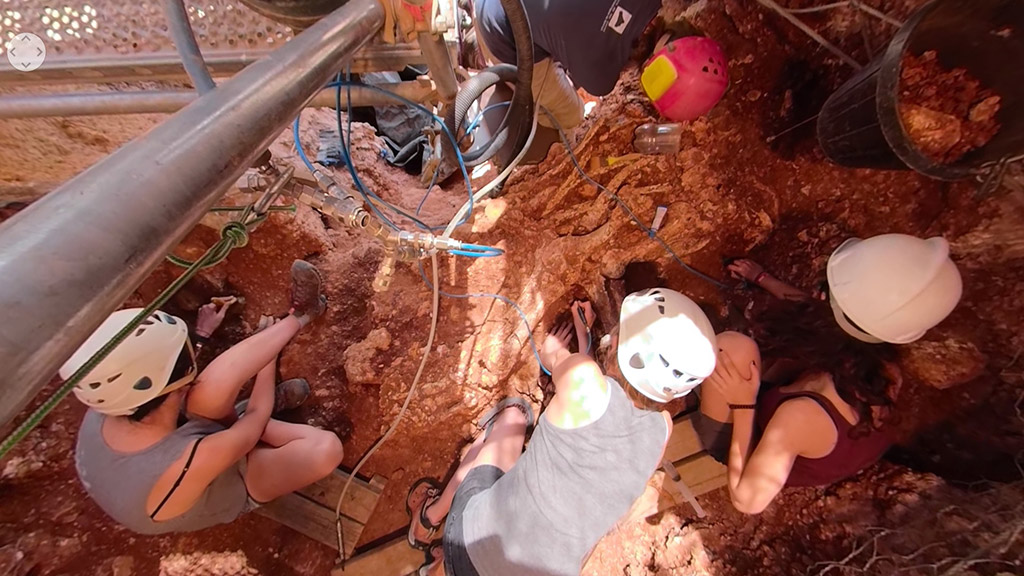The UOC recreates animals from over 100,000 years ago discovered at a dig in Castelldefels
Immersium Studio, a UOC spin-off company, offers the public immersive experiences so they can see first-hand how archaeologists work and discover for themselves what these long-ago species were really like
From 7 February, the Ramon Fernàndez Jurado Library in Castelldefels (Carrer del Bisbe Urquinaona, 19-21) will be housing an exhibition with some of the archaeological remains that researchers from the University of Barcelona unearthed at the town's Cova del Rinoceront (Rhinoceros Cave). The Universitat Oberta de Catalunya (UOC) is taking part in the Town Council exhibition with augmented and virtual reality experiences so that the public can get up close and personal with the work of the archaeologists and see what the animals they found were really like.
The exhibition, entitled "Espai Prehistòria. Fauna, canvi climàtic i arqueologia al Garraf" (A Walk in Prehistory: Fauna, climate change and archaeology in El Garraf), has been designed to show visitors what the climate, environment and fauna were like in this area 100,000 years ago. The exhibition's main feature is the complete skeleton of a baby straight-tusked elephant (Elephas antiquus) of about 5 or 6 years of age that was discovered in 2012. At 100,000 years old, these remains of the now extinct species are one of the few of their kind in Europe, and are on display for the first time thanks to the exhibition. The space also houses other highly unique, never-before-seen remains found at the site, such as the skull and jawbone of a sub-adult rhinoceros from another now extinct species (Stephanorhinus hundsheimensis) or the skull of a Mediterranean deer (Haploidoceros mediterraneus). Mediterranean deer are also now extinct but once frequented Southern Europe during warm periods. In fact, more remains of this species have been found at the Cova del Rinoceront than anywhere in the world.
Technology brings a dig and the animals it unearths to life
In order to bring the public closer to the researchers' work and recreate the animals found at the site, Immersium Studio, a UOC spin-off company, has used augmented and virtual reality to create audiovisual media. Thanks to these immersive experiences, exhibition visitors will be able to feel like they are on the dig. "We took a photo every ten seconds over the four days of the Cova del Rinoceront dig and created a 360-degree time-lapse video so you can really feel like you are at the site as the remains of a rhinoceros are unearthed", explained Luis Villarejo, co-founder of Immersium Studio. To mark the archaeological find, the UOC spin-off has also developed an immersive resource so visitors can accompany the archaeologists in the field as well as in their laboratory.
In addition, Immersium Studio worked with palaeontologists and archaeologists from the University of Barcelona to create animated 3D models of the rhinoceros, the deer and the elephant that visitors can download on their mobile phones using an app, giving them a glimpse of what these animals were like in real life. Villarejo said: "Working with the archaeologists and the Castelldefels Town Council at the site allowed us to see just how much immersive technologies can offer to archaeology, both in terms of raising the profile of archaeological work and this particular exhibition. These technologies have improved the visitor experience, giving each one the change to get to know the great professionals involved".
The site
The Cova del Rinoceront is unique as an archaeological site because it is one of the few places in the Mediterranean with archaeological remains ranging from 200,000 years to 80,000 years old. It is a little-known but quite interesting moment in the Earth's history, as, in terms of climate, it was a warm period similar to today's, precursor to the arrival of the great freezes of the last Ice Age. The numerous skeletons of prehistoric animals discovered at the dig have allowed researchers to study and reconstruct this period. In addition, various stone tools have been discovered in the area, evidence of very old human settlements by both Neanderthals (Homo neanderthalensis) and the first anatomically modern humans (Homo sapiens).
Archaeologists from the Quaternary Research Group, associated with the SERP (Seminari d'Estudis i Recerques Prehistòriques) group at the University of Barcelona, worked on the site. They were joined there by the Heritage Education and Museum Sciences (DIDPATRI) group from the same university and Immersium Studio (UOC) to create the exhibition for Castelldefels Town Council.
The work of Immersium Studio has the support of the Strategic Plan of the Knowledge Transfer and Value Creation Unit at the UOC (PETER), approved by the Government of Catalonia, which receives funding from the European Regional Development Fund (ERDF).


Press contact
-
Editorial department
